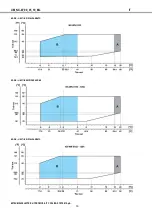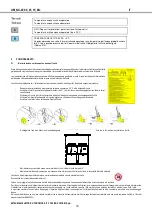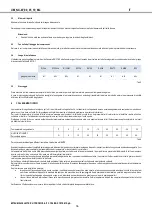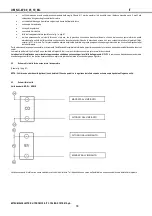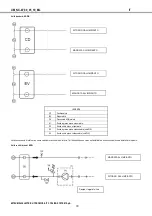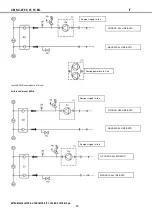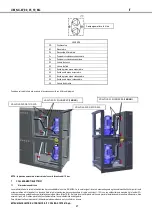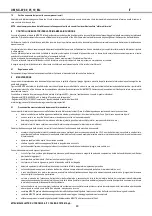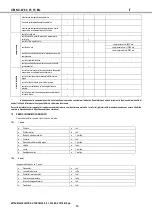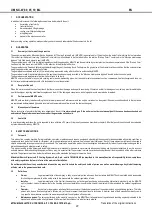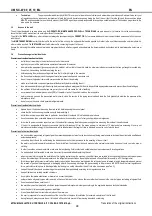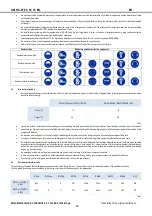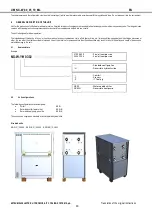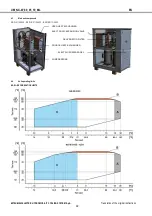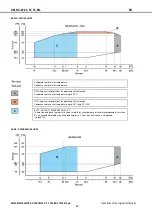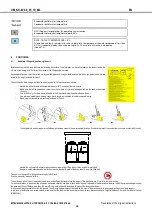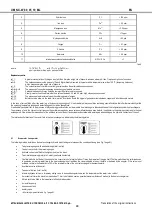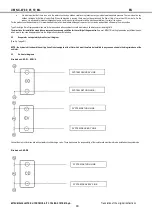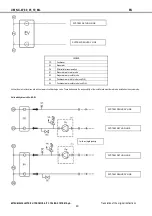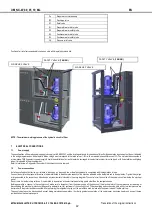
UM_NX-W_00_05_19_ML
EN
MITSUBISHI ELECTRIC HYDRONICS & IT COOLING SYSTEM S.p.A.
28
Translation of the original instructions
•
Technician:
The person authorised directly by MEHITS to carry out all operations of ordinary and extraordinary maintenance. He/she will also carry out
all regulations, checks, repairs and replacement of parts that should become necessary during the life of the unit itself. Outside Italy and those countries where
MEHITS and its subsidiary are not directly present, the MEHITS agent is personally responsible for acquiring a suitable number of Technicians proportional to the
area and to the business.
3.3
Access to the unit
The unit must be placed in an area where only the
OPERATORS, MAINTENANCE PEOPLE
and
TECHNICIANS
can gain access to it; otherwise it must be surrounded by a
fence that is at least 2 metres from the external surface of the machine.
The staff of the
INSTALLER
or any other visitors must always be accompanied by an
OPERATOR
. For no reason whatsoever must non-authorised persons be left on their own
with the unit.
The
MAINTENANCE MAN
must limit him/herself to the controls of the unit only; the only panel that can be opened by him/her is the one that accesses the control module - no
other must be touched. The
INSTALLER
must limit him/herself to connecting the plant to the unit.
Access the unit using the relative personal protective equipment and only after having read and understood the documents and instructions, which must always be kept close at
hand.
3.4
Precautions against residual risks
Prevention of residual mechanical risks
•
install the unit according to the instructions set out in this manual
•
regularly carry out all the maintenance operations foreseen in this manual
•
wear protective equipment (gloves, eye protection, hard hat, etc.) suited to the work in hand; do not wear clothes or accessories that can get caught or sucked in by
flows of air; tie back long hair before entering the unit
•
before opening the machine panelling make sure that it is firmly hinged to the machine
•
the fins on heat exchangers and the edges of metal components and panels can cause cuts
•
do not remove the guards from mobile components while the unit is operating
•
make sure that mobile component guards are fitted correctly before restarting the unit
•
fans, motors and belt drives might be running: before accessing these, always wait for them to stop and take appropriate measures to prevent them from starting up
•
the surfaces of the machine and pipes can get very hot or cold and cause the risk of scalding
•
never exceed the maximum pressure limit (PS) of the water circuit of the unit indicated on the rating plate
•
before removing parts on the pressurised water circuits, close the section of the piping concerned and drain the fluid gradually to stabilise the pressure at the
atmospheric level
•
do not use your hands to check possible refrigerant leaks.
Prevention of residual electrical risks
•
disable the unit from the mains using the main switch before opening the control panel
•
check that the unit has been grounded correctly before starting it
•
install the machine in a suitable area; in particular, do not install it outdoors if it is intended for use indoors
•
do not use cables of an unsuitable diameter or extension cord connections, even for very short periods or emergencies
•
for units with power correction capacitors, wait 3 minutes after removing the electric power supply before accessing the inside of the switch board
•
if the unit is equipped with frequency converters (inverters), disconnect it from the mains and wait a minimum of 15 minutes before accessing it to carry out
maintenance: residual energy in the components, which takes at least this length of time to dissipate, poses the risk of electric shock
Prevention of other residual risks
•
the unit contains pressurised refrigerant gas: the pressurised equipment must not be touched except during maintenance, which must be entrusted to qualified and
authorised personnel
•
connect up the utilities to the unit following the indications set out in this manual and on the panelling of the unit itself
•
the water circuit contains harmful substances. Do not drink from the hydraulic circuit and make sure the material contained in it does not touch your skin, eyes or
clothing.
•
in order to avoid an environmental risk, make sure that any leaking fluid is collected in suitable devices in accordance with local regulations
•
if a part needs to be dismantled, make sure it is correctly re-assembled before starting the unit
•
when the rules in force require the installation of fire-fighting systems near the machine, check that these are suitable for extinguishing fires on electrical equipment
and on the lubricating oil of the compressor and the refrigerant, as specified on the safety data sheets of these fluids (for example, a CO2 extinguisher)
•
for units equipped with pressure relief valves (safety valves): when these valves are triggered, the refrigerant gas is released at a high temperature/speed; prevent
the release of gas from harming people or damaging objects; if necessary, discharge the gas according to the provisions of EN 378-3 and the local regulations in
force, particularly making sure to discharge fluids that belong to a safety class other than A1 into safe, open areas (see Tab.3);
•
keep all the safety devices in good working order and check them periodically according to the regulations in force
•
keep all lubricants in suitably marked containers
•
do not place flammable substances or materials in or near the system
•
solder or braze only empty pipes after removing all traces of lubricant oil; do not use flames or other heat sources in the vicinity of pipes containing refrigerant fluid
•
do not use naked flames near the unit
•
the machinery must be installed in structures protected against atmospheric discharge according to the applicable laws and technical standards
•
do not bend or hit pipes containing pressurised fluids
•
it is not permitted to walk or rest other objects on the machines
•
the user is responsible for overall evaluation of the risk of fire in the place of installation (for example, calculation of the fire load)
•
during transport, always secure the unit to the bed of the vehicle to prevent it from moving about and overturning

